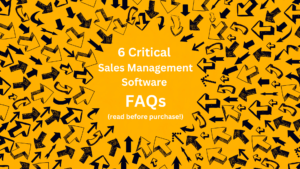Pipeline Must-Dos That Win Sales
Developing all aspects of the pipeline helps finish the sales race strong

By Tracy Larson
We last talked about how building the sales pipeline is similar to training for and running a marathon. Developing all aspects of the pipeline helps finish the sales race strong. Today, let’s dive into what to do at each stage – similar to checking your progress at specific distances in the race, verifying that you’re on track.
Most sales organizations have defined pipeline stages and expectations that those stages are being actively tracked and updated by salespeople. For goal-oriented people, understanding where you are relative to where you should be is critical to keeping you on the trail to success.
Why is tracking the sales pipeline so important?
Many people swear they operate best from the “gut.” Your gut can be a reliable indicator in certain situations. Still, the fact is that reaching goals such as running 26.2 miles or hitting your quota within a defined time frame requires performing against and tracking specific metrics.
Like a marathon, the path from contact to contract is neither straight nor level. There are unexpected curves (your key contact was just replaced with a new hire), hills to climb (the project budget has come under scrutiny), and other conditions that make progression more difficult at some phases than others. Because of this, pipeline tracking must be regimented, using clear definitions and a common language shared by your sales team. For example, an “Opportunity” has significantly more meaning when the pipeline stage “40% – Issues Identified” is included as a data point. That simple combination of information helps lead salespeople to identify and record a “next action” that keeps the sales pace up and advancing forward.
Each stage in the pipeline represents an aspect of your sales template and links an estimated percentage to goal. Moving opportunities successfully through all pipeline stages is equal to 100%, winning sales. Success is a function of the amount of activity in each stage of your pipeline coupled with your next actions. Simply put, it comes down to a numbers game. Carrying enough sales across the finish line to make quota requires maintaining a certain number of strong leads and opportunities throughout each of the previous stages, given the reality that some will drop off along the way. Tracking is key to maintaining or increasing pace.
What is the most critical thing to do at each pipeline stage?
The most necessary action within each stage of the pipeline is evaluating included opportunities, one-by-one, to assess whether they truly belong there. Three questions may help in this regard:
1) Is this prospect truly in a buying mode?
2) Why does this opportunity belong in this stage?
3) What must happen next and by when?
If the answer to the first question is “no” at any stage in the pipeline, then move the opportunity into the lost stage, record the reason for that decision in your CRM, and add a note and calendar reminder if you feel there may be some future opportunity. Otherwise, lose it fast and move on. Concentrate your energy and effort where success is possible!
If the prospect is in the buying mode, why is it in its current stage? What factors are contributing to this assignment? Recording a simple note to yourself (and your team) with this answer provides data to help validate that you are on track within that stage. Which leads to question three.
What happens next? This is the heart of the matter. In running, you track your time at mile markers. In sales, you are thinking about actions that need to occur to keep the opportunity alive and moving into the next sales stage. Your mindset should “always be closing.” Developing a list of “Next Action” items for quick selection in your CRM makes it more likely that you’ll commit to a specific task, while providing meaningful data to track your progress.
“Your pipeline is one of the most essential tools you have to gauge the probability of your success as a salesperson.”
How do I guarantee my pipeline is working for me?
Your pipeline is one of the most essential tools you have to gauge the probability of your success as a salesperson. It’s a barometer, a stopwatch, and a record of the play-by-play of your sales opportunities. To guarantee your pipeline is working for you, the most important action to take is regular pipeline review.
Do it daily – at least at first. Setting that cadence for yourself, a non-negotiable time, like time set aside for training, will help you to run a faster mile (if you will) or move more efficiently through your sales process. Regular review develops strength in each sales stage and enables you to spy outliers, moving opportunities into the correct sales and pipeline stage. It also helps hone your sales strategy. You’ll ask yourself and your prospects better questions, allowing you to more quickly and easily identify your next moves. Be honest throughout this process; there’s no shame in moving an opportunity back a stage or two, or retiring those that are slowing you down and wasting time.
Sales are played differently by each salesperson. We each have different physical and mental strengths and weaknesses, different approaches to the same race. Like with any endeavor, we learn new strategies by identifying the superstars and emulating their behaviors. Some will work for us, and others won’t, but the key is to keep learning.
What are your pipeline must-do’s? How do they help you to be a better salesperson?
Recent Post

Valsoft Acquires WeSuite to Enter Sales Management Software Space
Valsoft Corporation Inc. (“Valsoft”), a Canadian company specializing in the acquisition and development of vertical market software businesses, is pleased to announce the acquisition of WeSuite…

Three Top Selling Tips from Sales Superstar Neil Riveron
I love connecting with great salespeople and getting their top tips on selling. Here are 3 great tips from Rapid Response’s Neil Riveron…

Six Critical FAQs About Sales Management Software for Security Companies
In the market for sales estimating software? Read this before purchase!…

Coach Your Team to Greater Sales: How Sales Management Software Helps – Part 2
Want to know how sales estimating software is a great sales coaching tool? Read on.